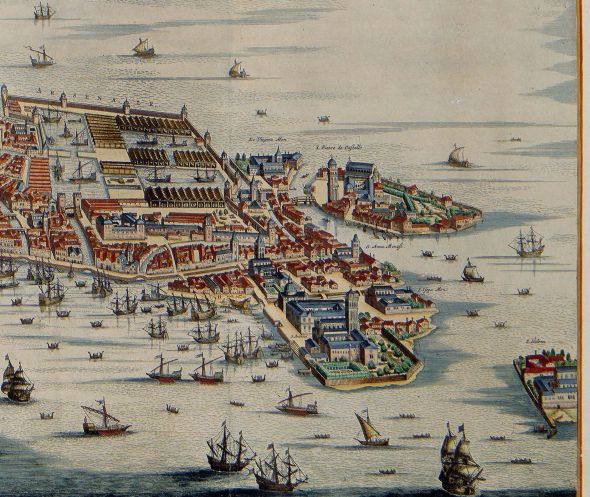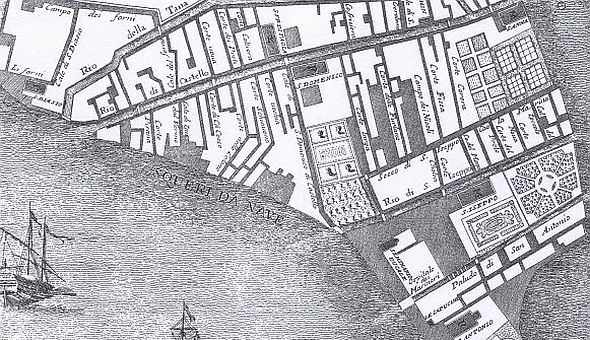We left our story — “The Interminable Quest for the True Provenance of the Viale Garibaldi, as Recounted by People Living and Dead (I suppose that should be “living or dead”), with Illustrations and Funny Spelling” — at an uncomfortable point between things I knew and things I only thought I knew.
Several readers have since written me giving me more information and opinions than I’d expected (that’s not saying much, considering that I expected none). My ensuing labors to sift, evaluate, cross-check, confirm, and make at least one educated guess have led me to the last thing I’m going to say about viale Garibaldi. Not that there couldn’t be more, and there probably is more, but my interest is dimming and I’d bet yours is too.
The story so far:

Canaletto painted a picture showing a section of Castello as it no longer appears. I deduced from the painting that the vantage point from which he painted it was a canal which was later filled in to make the present gravel walkway lined by lime trees named the viale Garibaldi.
Please note that much confusion can be avoided by remembering that via Garibaldi and viale Garibaldi are not the same thing. “Viale” is a word which, among various translations, means “tree-lined avenue.”
A reader questioned my original assertion and its various geographical and geometrical elements, and proposed that the water seen in the painting was instead a glimpse of the Bacino of San Marco, where its rippling wavelets caressed the smooth stone surface of a working riva (fondamenta). He proposed it in less overwrought terms.
I found a map by Joan Blaue (date unknown by me, except that it was made in the 1600’s) which shows that there was indeed a riva in that place, leading down into the waters of the Bacino of San Marco, and not at all the canal I had imagined.
In brief, I was wrong and he was right.

Another reader then wrote with more information and opinions, and attached a detail from another map, which I am showing here. It was made by Ludovico Ughi in 1729 — slightly after Canaletto’s time, but probably not long enough to matter to our story.
As you see, Ughi identifies a clearly non-canal strip of territory as “Cale di S. Domenico di Castello.” If it was a calle (street) in 1729, I’m going to assume it was a calle in 16-whatever-it-was when Canaletto painted his picture.
Or maybe you can’t see it. It’s the broad line that begins in the “crook” of the waterfront and goes north till it hits the “rio di Castello,” the canal which became via Garibaldi.

Conclusion: Making assumptions can be dangerous, as my original post demonstrated, but I think the evidence is now reasonably clear that the present viale Garibaldi was not a canal in the 17th century.
That’s really all I’m interested in saying about this. Whatever it was, or wasn’t, or dreamed of being, but couldn’t, or might have been if Napoleon or Nikola Tesla or Fannie Bloomfield Zeisler hadn’t intervened, is a story I’m not going to be pursuing anymore.
I’m all for knowledge — the more, the better, even as it gets broken and reassembled in ever-tinier pieces and shapes. But unless somebody can convince me that Jimmy Hoffa is buried under the third bench on the right, I’m going to leave this subject and go on to something else. Perhaps something more interesting, maybe even more important. But at least it won’t be about the viale Garibaldi.


1 Comment
Thanks for braving the rabbit hole and making it back out.